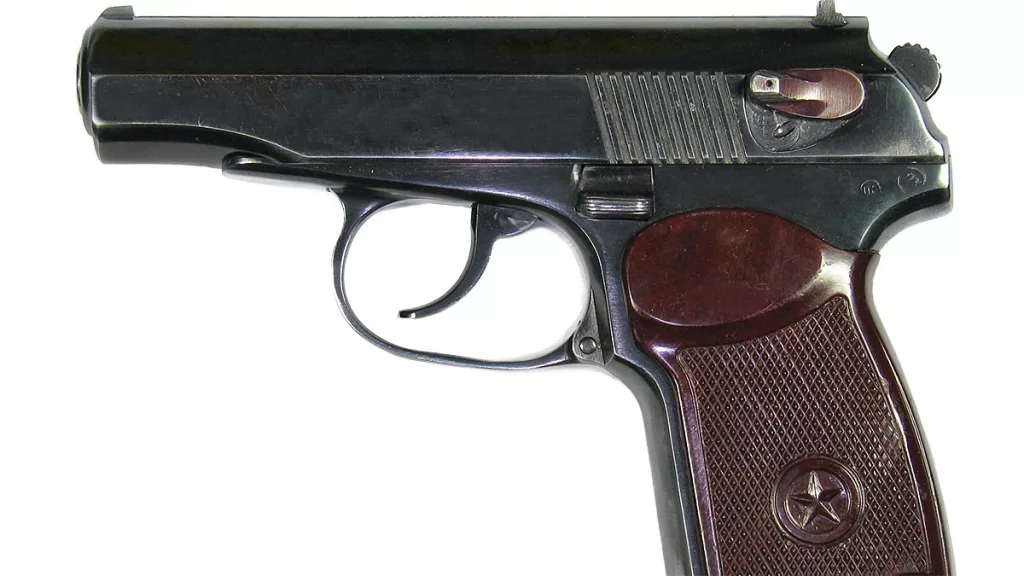Perhaps the most famous Soviet weapon is the ubiquitous AK-47 which has stood the test of time and is still found everywhere in the world, especially among terrorist groups. Nevertheless, the AK isn’t the only Soviet weapon that has survived the test of time. The much less-spoken-about Makarov PM pistol is still widely used although it was first introduced in 1951.
The Origins of the Makarov PM Pistol
The Soviet Union fought World War II, (or the Great Patriotic War, according to them) with the obsolescent Nagant M1895 revolvers or the semi-automatic Tokarev TT pistols.
The Tokarev was simple, sturdy, reliable, had good stopping power, and like most Soviet weapons was able to fire in the mud, dirt, and dust. But it didn’t have a safety. So an upgrade was looked for.
The Soviets borrowed heavily from the German Walther PP design. While the Red Army hated Germany and the Nazis they had an affinity for German weapons. (The Soviets also used another German weapon, the StG-44, also known as the MP-44, to base their iconic AK-47 on, even down to the shortened 7.62 x 39mm round, which was similar to the German 7.92 x 33 mm.)
The Red Army was looking for a pistol that would use the 9.2 x 18mm cartridge and be double-action à la Walther PP’s design.
Several designs were submitted and tested by designers Korovin, Baryshev, Vojvodin, Simonov, Rakov, Klimov, Lobanov, Sevryugin, and Makarov. Special emphasis was placed by the Red Army on safety, simplicity, accuracy, weight, and dimensions.

The trials resulted in 1948 in the selection of the Makarov pistol in 9×18 as the Soviets’ next military sidearm. However, it took a few years of design changes and small tweaks before it was officially adopted in December 1951 as the “9mm Pistolet Makarova” or PM in short.
Like many other Soviet weapons systems, the Makarov PM stood out for its simplicity, reliability, quick disassembly, and robustness. The pistol has a straight blowback action and is made completely out of steel.
The Makarov Through Time
During the 1960s, the Soviet army was looking to reduce the pistol’s weight by switching to an aluminum/titanium alloy and later a polymer frame. So several design changes were made.
However, the alloy frames turned out to be too expensive. The polymer frames — although they passed all of the testing requirements with ease — were rejected as the military was unsure of the effects long-term storage would have on the frame’s stability.
The Soviets later developed a newer more powerful cartridge, the 9×18 PMM. This cartridge had a muzzle velocity of 430 meters per second compared to the 315 meters per second of original 9x18mm ammunition. The Soviets also developed a larger capacity 12-round version of the Makarov PM, along with the new round. The new version included a slight grip frame redesign to accommodate the thicker magazine.

The Markov PM was issued to NCOs, police officers, special forces (Spetsnaz), as well as tank and aircrews. A suppressed version (PB), was issued to Spetsnaz for the conducting of “wet work” targeted assassinations and kidnappings. It remained in wide front-line service with the Soviet military and police until and beyond the end of the USSR in 1991.
In 2003, the Makarov PM was formally replaced by the PYa pistol. Still, the pistol can still be found in large numbers in many of the Russian second-tier units and their allies.
An Effortless Disassembly and a Prized Item
Disassembling the Makarov PM was very easy only requiring the following steps:
- Remove the magazine by pressing the magazine release at the base of the grip and remove the magazine;
- Ensure that the chamber is empty;
- Pull the trigger-guard downwards, then swing it to one side to lock in the open position;
- Pull the slide all the way back, then raise the rear of the slide off of the top of the frame rails;
- Ease the slide forward and off the barrel;
- Remove the return spring from the barrel.
During the Cold War, the pistol was highly sought after as a souvenir. During the 1980s, this author tried unsuccessfully to trade a Makarov PM from a Contra, who had taken it off of a Nicaraguan officer, but the Contra wouldn’t bite… Oops. Oh well, OPSEC this many years later is moot.
But after the fall of the Soviet Union, the Makarov became much more available for the gun collector or hobby shooter.
The Makarov is compact, reliable, reasonably accurate out to 25 meters, and fun to shoot. It is truly one of those iconic Soviet-era weapons.










COMMENTS
You must become a subscriber or login to view or post comments on this article.